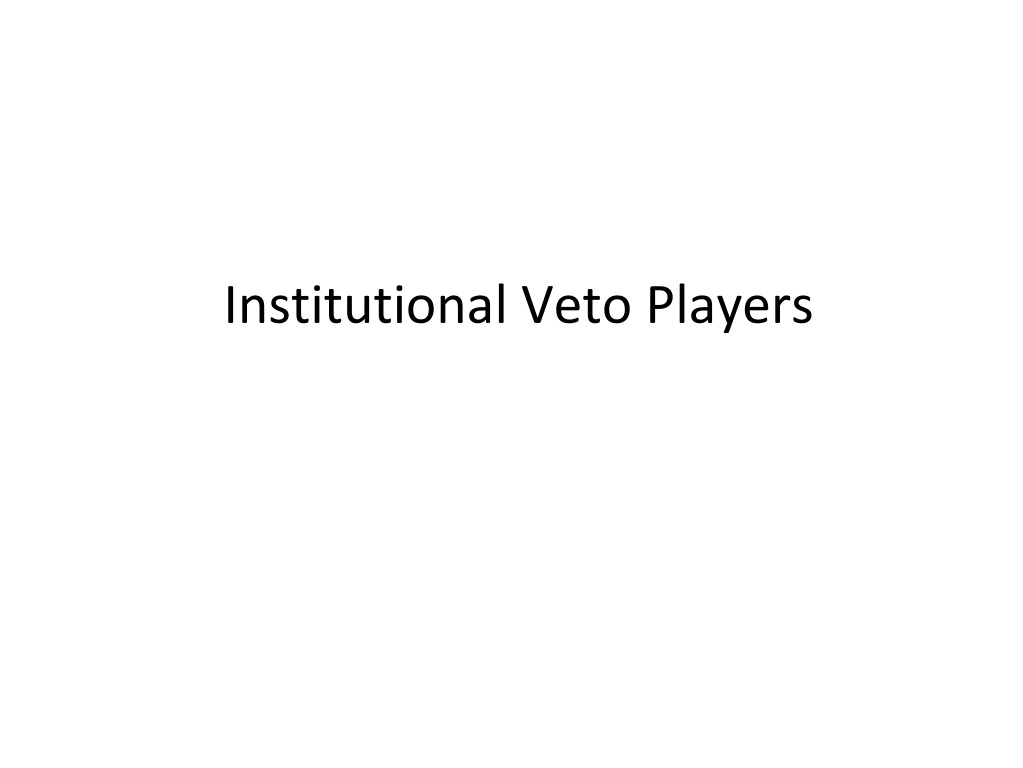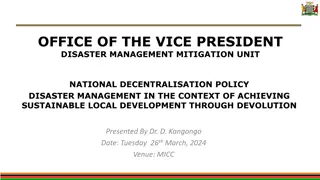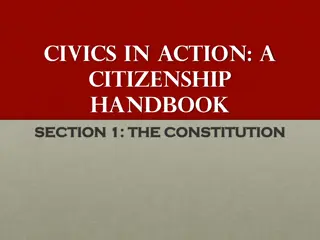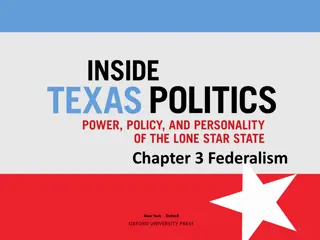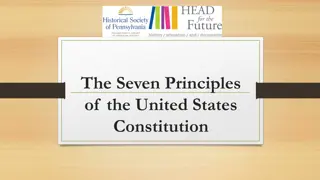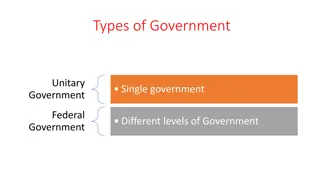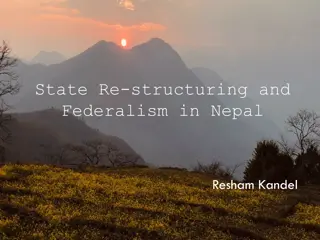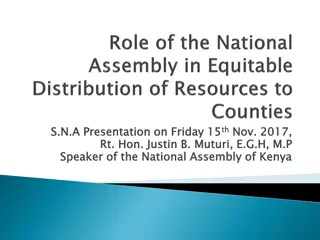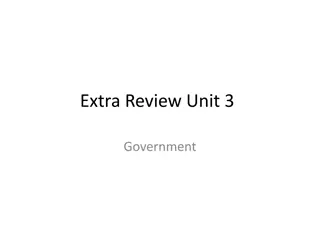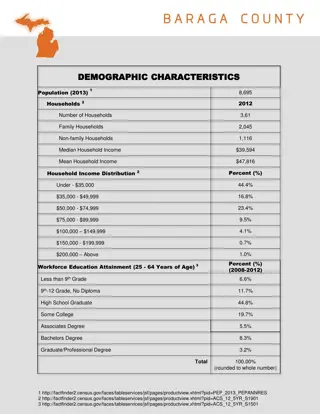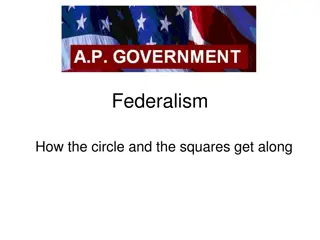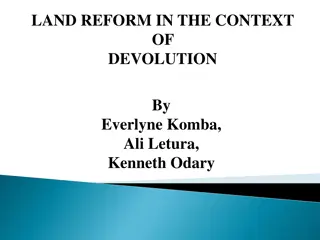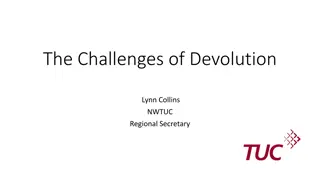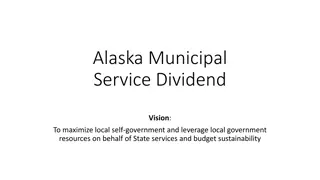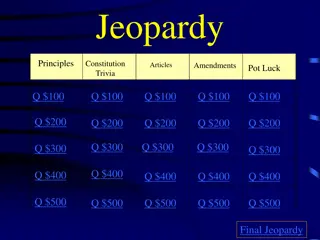Understanding Federalism and Devolution in Government Structures
Federalism encompasses the division of sovereignty between territorial levels, while devolution grants powers to subnational governments with the right to recall them. This approach is evident in countries like India. The structural components of federalism involve geopolitical division, independence, and direct governance, distinguishing between federalism in structure and practice. Look at examples such as Guyana, Suriname, and more to gain insight into federalism at work.
Download Presentation

Please find below an Image/Link to download the presentation.
The content on the website is provided AS IS for your information and personal use only. It may not be sold, licensed, or shared on other websites without obtaining consent from the author. Download presentation by click this link. If you encounter any issues during the download, it is possible that the publisher has removed the file from their server.
E N D
Presentation Transcript
Its useful to distinguish between federalism in structure and federalism in practice. Federalism in structure Federalism. Federalism in practice Decentralization.
Federalism has three structural components. 1. Geopolitical division 2. Independence 3. Direct governance
A federal state is one in which sovereignty is constitutionally split between at least two territorial levels so that independent governmental units at each level have final authority in at least one policy realm. States that aren t federal are known as unitary states.
GUYANA SURINAME VENEZUELA French Guiana (Fr.) ATLANTIC OCEAN COLOMBIA AMAP RORAIMA PERNAMBUCO Bel m Manaus RIO GRANDE DO NORTE PAR Brazil. Federal (1) State (26) Municipal (5,570) MARANH O PARA BA AMAZONAS CEAR B R A Z I L PIAUI Recife ACRE Porto Velho TOCANTINS ALAGOAS SERGIPE PERU MATO GROSSO ROND NIA BAHIA Salvador Cuiab BRAS LIA GOIAS BOLIVIA DISTRITO FEDERAL MINAS GERAIS MATO GROSSO DO SUL ESP RITO SANTO Belo Horizonte S O PAULO RIO DE JANEIRO PARAGUAY CHILE Rio de Janeiro PARAN PACIFIC OCEAN STA CATARINA RIO GRANDE DO SUL Porto Alegre ATLANTIC OCEAN ARGENTINA URUGUAY
Devolution Federalism Devolution occurs when a unitary state grants powers to subnational governments but retains the right to unilaterally recall or reshape those powers. Regional governments in a unitary state don t have a constitutional right to any of their powers.
India is an example of a unitary country that has devolved power to subnational governments. Article 3 gives the national legislature the power to change state boundaries and to create new states from existing ones. Article 356 allows the president to take over a state s executive and rule directly through an appointed governor.
Federal states can be congruent or incongruent. Congruent federalism exists when the territorial units of a federal state share a similar demographic makeup with one another and the country as a whole. Incongruent federalism exists when the demographic makeup of territorial units differs among the units and the country as a whole.
Federal states can be symmetric or asymmetric. Symmetric federalism exists when the territorial units of a federal state possess equal powers relative to the central government. Asymmetric federalism exists when some territorial units enjoy more extensive powers than others relative to the central government.
Whether a state is federal or unitary is ultimately a constitutional issue. Whether a state is decentralized or not is about where policy is actually made.
Decentralization refers to the extent to which actual policymaking power lies with the central or regional governments. Most political scientists see decentralization as a revenue issue. The greater the share of all tax revenues going to the central government, the less decentralized the state.
Central Governments Share of Tax Revenue Singapore Bangladesh Bhutan 100 Malaysia New Zealand Jamaica Cambodia Guyana Bahamas Pakistan 90 Belize El Salvador Peru Ireland Indonesia Estonia Malta 80 Mexico Philippines AVERAGE Israel United Kingdom Colombia Iceland Vietnam 70 Ecuador Nicaragua Bulgaria Portugal Bolivia Argentina Greece Austria Turkey 60 AVERAGE Italy Slovakia Costa Rica Czech Republic South Korea Sweden Latvia 50 Belgium Poland Finland Slovenia Canada Brazil 40 United States China Spain Switzerland France 30 Germany 20 UNITARY FEDERAL
Two Dimensions of Federalism Decentralized Germany, Switzerland United States, Canada, Brazil, Belgium France, China, Spain, Slovenia, Finland, Poland, Sweden, Latvia Unitary Federal Singapore, Bangladesh, Bhutan, Jamaica, New Zealand, Cambodia, Guyana, Bahamas Malaysia, Pakistan, Mexico Centralized
Coming-together federalism is the result of a bargaining process in which previously sovereign polities voluntarily agree to give up part of their sovereignty in order to pool together their resources and improve their collective security or achieve other, economic goals. Holding-together federalism is the result of a process in which the central government of a polity chooses to decentralize its power to subnational governments in order to diffuse secessionist pressures.
Potential advantages of federalism. Closer match between policy and citizen preferences. Greater government accountability by bringing the government closer to the people. Competition among states creates an incentive for good government. Policy experimentation. System of checks and balances.
Potential disadvantages of federalism. Unnecessary duplication and contradictory policies. Increases collective action problems in policy formulation. Competition leads to downward harmonization. Competition amplifies pre-existing inequalities. Facilitates blame shifting and credit claiming, thereby reducing government accountability.
A unicameral legislature is one in which legislative deliberation occurs in a single assembly. A bicameral legislature is one in which legislative deliberation occurs in two distinct assemblies. About 40% of the world s countries have bicameral legislatures.
Bicameral systems can be congruent or incongruent. Congruent bicameralism occurs when two legislative chambers have a similar political composition. Incongruent bicameralism occurs when the two legislative chambers differ in their political composition.
There are four methods of selecting members of the upper house: 1. Heredity 2. Appointment 3. Indirect elections 4. Direct elections
Members of the lower chamber are usually supposed to represent all citizens equally. The most common role for the upper chamber is to represent the citizens of subnational geographic units. This is always the case in federal states, but is also the case in some unitary states.
The fact that citizens are often distributed in an unequal manner across the different subnational geographic units frequently leads to malapportionment. Malapportionment occurs when the distribution of political representation between constituencies isn t based on the size of each constituency s population. In a malapportioned system, the votes of some citizens weigh more than the votes of others.
Malapportionment in Upper Chambers, 2019 Seats held by the percentages of the most favorably represented citizens (percentages) 10 20 30 50 United States 39.3 53.9 65.5 82.4 Switzerland 39.3 53.1 63.0 80.6 Australia 33.1 49.6 58.9 73.2 Canada 37.3 46.1 50.6 65.7 Germany 26.0 43.4 55.5 74.4 India 13.7 25.1 36.3 56.2 Austria 12.2 22.6 32.3 52.9 Belgium 11.2 21.2 31.1 50.7
Bicameral systems can be symmetric or asymmetric. Symmetric bicameralism occurs when the two legislative chambers have equal or near equal constitutional power. Asymmetric bicameralism occurs when the two legislative chambers have unequal constitutional power.
Two Dimensions of Bicameralism Symmetric Weak Bicameralism Strong Bicameralism Italy, Japan Australia, Germany, Switzerland, United States Congruent Incongruent Insignificant Bicameralism Weak Bicameralism Austria, Bahamas, Jamaica Canada, France, India, United Kingdom Asymmetric
Bicameralism can find its origins in the concept of mixed government outlined in ancient Greece. Mixed government calls for different institutions to represent the interests of the different social classes. By creating a system of checks and balances, mixed government was supposed to prevent one social class from dominating all of the others.
The rise of republicanism in the 18th century saw an emphasis on the representation of the people as a whole rather than as a set of competing social classes.
Bicameralism increasingly became seen as a way for federal states to represent their constituent territorial units. The lower chamber would represent the popular dimension of the people s will. The upper chamber would represent the territorial dimension of the people s will.
Some unitary states have retained an upper legislative chamber. In most cases the power of the upper chamber has been significantly weakened. Those in the upper chamber are thought to have characteristics of value wisdom, age, knowledge that those in the lower chamber may not. This incongruence is achieved by appointing people to the upper chamber.
Two basic arguments in favor of bicameralism. 1. In federal countries, bicameralism is primarily defended as an institutional means for protecting the federal system and promoting the distinct preferences of different territorial units. 2. In unitary countries, bicameralism is primarily defended as an institutional means for improving the quality of legislation.
Constitutionalism refers to the commitment of governments to accept the legitimacy of, and be governed by, a set of authoritative rules and principles that are laid out in a constitution. A system of constitutional justice comprises the set of institutions and procedures that are established to protect constitutional rules and principles.
A constitution provides the formal source of state authority. In addition to establishing the structure, procedure, powers, and duties of governmental institutions, more recent constitutions also contain a list of guaranteed rights.
Constitutions can be codified or uncodified. A codified constitution is one that s written in a single document. An uncodified constitution is one that has several resources, which may be written or unwritten. Only Israel, New Zealand, and the UK have an uncodified constitution.
Constitutions can be entrenched or unentrenched. An entrenched constitution can be modified only through a special procedure of constitutional amendment. An unentrenched constitution has no special amendment procedure and can be modified at any point in time with the support of a legislative majority.
Historically, we can identify two ideal types of constitutions. 1. Legislative supremacy constitution: No constitutional review, no bill of rights, and not entrenched. 2. Higher law constitution: Constitutional review, a bill of rights, and is entrenched.
Constitutional review is the authority of an institution to invalidate legislation, administrative decisions, judicial rulings, and other acts of government that violate constitutional rules, such as rights.
Constitutional review is exercised by judges sitting on special tribunals constitutional courts that aren t part of the regular judicial system. When constitutional review is conducted by ordinary judges from the regular judicial system, it s commonly referred to as judicial review.
The new constitutionalism describes a situation in which almost all countries now have a higher law constitution.
Despite the convergence on higher law constitutions, countries differ in their system of constitutional justice. Type of constitutional review Timing of constitutional review Jurisdiction of constitutional review
Type of constitutional review Abstract constitutional review involves the constitutional review of legislation in the absence of a concrete legal case. Concrete constitutional review involves the constitutional review of legislation with respect to a specific legal case.
Timing of constitutional review A priori constitutional review occurs before a law is formally enacted. A posteriori constitutional review occurs only after a law is formally enacted.
Jurisdiction of constitutional review Centralized constitutional review refers to a situation in which only one court can conduct constitutional review (European Model). Decentralized constitutional review refers to a situation in which more than one court can interpret the constitution (American model).
Veto player theory offers a way to think about political institutions in a consistent way across countries. It conceptualizes the institutional structure of a given country in terms of its configuration of veto players.
A veto player is an individual or collective actor whose agreement is necessary for a change in the political status quo. An institutional veto player is generated by a country s constitution. A partisan veto player is generated by the way the political game is played.
Federalism, bicameralism, and constitutionalism can be conceptualized as different types of institutional veto players. All three institutions place hurdles on the ability of political actors to change the status quo.
Veto player theory indicates that countries with many veto players who have conflicting preferences will be characterized by: 1. Greater policy stability 2. Smaller policy shifts 3. Less variation in the size of policy shifts 4. Weaker agenda-setting powers
